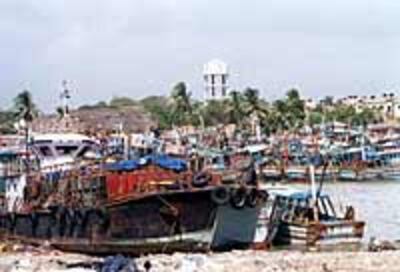
Indian officials say they have launched the biggest relief effort in the country's history in the state of Tamil Nadu where estimates are now putting the death toll from last week's tsunami at 9,500. Nearly 6,000 people are reported still missing. International aid groups are criticizing the Indian government's refusal to allow non-governmental agencies to assist in devastated areas.
RFA reporter Pema Ngodup, tired and nauseated from the smell of disease-preventing chemicals, filed this report from his hotel lobby in the coastal town of Thirukkayaiyur in south India.
I went to four places today, traveling by taxi. In Nagappattinam, the fishing trawlers have been pushed out by the sea and now rest on top of the houses. And the machinery that is clearing the remains of destroyed houses are uncovering bodies, lots of bodies. It was smelling very bad. There are a lot of international reporters there, everybody is there.
Velankanni, a town less than one kilometer (5 miles) south of Nagappattinam, was also affected by the tsunami. Vailankanni is the site of the church of "Our Lady of Vailankanni," a holy shrine devoted to the Blessed Virgin Mary.

About 1,000 local people are feared dead, and many more pilgrims are believed to have died as well. Every year pilgrims and tourists come to visit "Our Lady of Vailankanni" during the Christmas holiday. Tradition has it that the Blessed Virgin Mary appeared three times to people there and asked that a church be built on the site where she appeared.
Fighting took place when a volunteer brought some rice to the earthquake victims and people from another village who had not suffered any damage came down to take the rice and sell it. The organizer told me that he was very sad; he started with a good intention to help the needy people and then this fighting occurred.
Still Little Relief
They (the people) have not been taught to stand up for themselves so they just wait for government help.
Everywhere supplies are slow to come. I have spoken to some state ministers and they say that high officials are coming. They said a decision will be taken the day after tomorrow on whether outside help is going to be allowed. They say that they are doing a step-by-step investigation. I also spoke to an official in Pondicherry who said he had already brought in rice and blankets and I went to a village where people said they had gotten them.
But in other places, people are getting angry and they say the government is doing nothing. They have not been taught to stand up for themselves so they just wait for government help. They have lost every thing, their fishing boats, their homes…The old people who lost their homes and their family members, they are very sad. Others are starting to think of their future, but they don’t know anything else other than fishing. So they say if the government tells them, 'You are going to get a boat and some nets,' they are satisfied.
People have taken refuge in schools, in colleges, in community halls. I have seen a lot of people coming from other places, like Karnataka and other southern states, bringing support to those in need. They come by trucks, buses, minibuses; there are a lot of vehicles. They are school girls, doctors, lawyers, political people… I have seen some Tibetan monks in Madras and some Tibetan business men who had come to distribute clothing and give aid.
During the last few days, I have learned a lot about people’s experiences, about their sadness and about helping each other.
